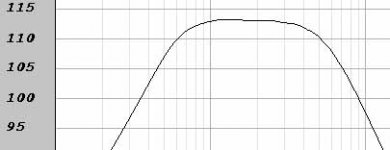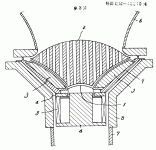Hmm input and output data is as in the paper. Below system specified between 30Hz-300Hz with 10:1 compression ratio:
Code:
Constants
c 343.2 m/s
p0 1.29 kg/m3
Input data
Vb, Vrc 0.02 m3
Sd 0.088 m2
St, S1 0.0088 m2
fl 30 Hz
fh 300 Hz
Rin 8 Ohm
Re 6 Ohm
Output data
fc 94.9 Hz
Qtc 0.29
Qec 0.61
Qts 0.22
Qms 0.41
Qes 0.46
Vat 0.0088 m3
alfa 0.79
fs 71 Hz
Vas 0.015753696 m3
Cmd 1.34E-05 m/N
Mmd 0.3758 kg
Res 2 Ohm
Bl 28.7 Tm
n 44.6%
Vaf 5.00E-04 m3
f3 362.67 HzHey Jack,
With these figures we are still totally out of bounds when designing a horn strictly from Leach. A 30Hz horn(T=0,8) will have over 150x compression being almost 10m long in 4Pi(floor/wall). Vb will also be negative!
About Sd, is this really the diaphragm area? Also Mmd is unrealistic for this a small diaphragm.
Putting your data into Hornresp gives you a to big compromise when using a, delicate and probably not cheap, driver like this. Instead one should input the data from my Optimizer.
Do you want me to mail the spreadsheet?
With these figures we are still totally out of bounds when designing a horn strictly from Leach. A 30Hz horn(T=0,8) will have over 150x compression being almost 10m long in 4Pi(floor/wall). Vb will also be negative!
About Sd, is this really the diaphragm area? Also Mmd is unrealistic for this a small diaphragm.
Putting your data into Hornresp gives you a to big compromise when using a, delicate and probably not cheap, driver like this. Instead one should input the data from my Optimizer.
Do you want me to mail the spreadsheet?
Last edited:
Hello Jack,
Several years ago I used to work with few friends on a project of low-mid compression driver.
(but unfortunately when it came to prototyping money went to lack....)
A compression ratio of 10:1 is very large for a bass driver. Most low-mid and bass driver I know (Goto, Ale...) use ratio of smaller value (2 to 4).
Also they use very few or no slits in their phase plug.
Best regards from Paris, France
Jean-Michel Le Cléac'h
Several years ago I used to work with few friends on a project of low-mid compression driver.
(but unfortunately when it came to prototyping money went to lack....)
A compression ratio of 10:1 is very large for a bass driver. Most low-mid and bass driver I know (Goto, Ale...) use ratio of smaller value (2 to 4).
Also they use very few or no slits in their phase plug.
Best regards from Paris, France
Jean-Michel Le Cléac'h
Hmm input and output data is as in the paper. Below system specified between 30Hz-300Hz with 10:1 compression ratio:
Of course such a large Mmd is impractical for 880cm Sd. Qms was too low. More likely 5 or even 9 as Hornresp suggests. I don't see any bugs between spreadsheets - just correct Sd and Fh.
Jean-Michel. Compression ratio - seems a mystery of Thuras driver. Can't get decent results with 1:4 🙂
Jean-Michel. Compression ratio - seems a mystery of Thuras driver. Can't get decent results with 1:4 🙂
OK, then we have bigger diaphragm than a 15". When adjusted we will still have a 10:1 compression and a just acceptable upper limit of 200Hz.
Still Mmd=376gr is unrealistic. I imagine a light diaphragm would be preferable.
Couldn´t one use a conventional 15" instead?
Still Mmd=376gr is unrealistic. I imagine a light diaphragm would be preferable.
Couldn´t one use a conventional 15" instead?
Good question - 12pi, Labhorn, maybe some old WE's work well so why we bother? For me checking different membrane materials, weights, suspensions is quite easy but I need decent motor first. Ferrites allow 1.5T, neo is expensive, field coil left 🙂
I'll soon. quick and dirty MB of some available woodscrap 🙂use a conventional 15" instead?
0.5pi:
Attachments
Last edited:
Are you aiming to design a driver for a specific passband, or are you just trying to re-create the thuras driver for historical interest?
I'm suspicious Thuras would have gone about his designing quite differently if he'd had today's simulation tools...
I'm suspicious Thuras would have gone about his designing quite differently if he'd had today's simulation tools...
Are you aiming to design a driver for a specific passband, or are you just trying to re-create the thuras driver for historical interest?
I'm suspicious Thuras would have gone about his designing quite differently if he'd had today's simulation tools...
What do you suspect, Thuras would have done differently , today ?
specially, considering the revival of field coil motors ?
I have no problem at all with field coil drivers. I actually designed one a couple years ago for a start-up high-end outfit that was aborted in the financial collapse. And I think the Thuras driver is a gorgeous beast, and I'd love to see someone recreate it just so I could look at it.
But if I were aiming at creating wide-bandwidth horn bass, and money, space and horn length were no issue,I would lean more toward a design along the lines of the other bass compression drivers you cited--Goto, Ale, etc.--that bear no resemblance to the Thuras driver. If money, space or horn length was an issue, then several existing cone bass drivers are already highly adapted to suit (granted, there's little fun in that, though.)
That's why I'm curious about the goal here. If the goal is just to create a first-class homage to a lovely piece of audio history, then by all means rock on!
But if I were aiming at creating wide-bandwidth horn bass, and money, space and horn length were no issue,I would lean more toward a design along the lines of the other bass compression drivers you cited--Goto, Ale, etc.--that bear no resemblance to the Thuras driver. If money, space or horn length was an issue, then several existing cone bass drivers are already highly adapted to suit (granted, there's little fun in that, though.)
That's why I'm curious about the goal here. If the goal is just to create a first-class homage to a lovely piece of audio history, then by all means rock on!
Last edited:
hi Bill
there is a reason, that make Steve Shell make comments like this :
Never before had I heard such see-through clarity and naturalness in bass reproduction.
the aim should be the best bass reproduction that is possible......
I don't see why the Goto or Ale bass horndriver should sound better, than the Thuras. The most highly praised and most expensive compression drivers are still the WE-555, and WE-594, made by the same team of engeneers....
there is a reason, that make Steve Shell make comments like this :
Never before had I heard such see-through clarity and naturalness in bass reproduction.
the aim should be the best bass reproduction that is possible......
I don't see why the Goto or Ale bass horndriver should sound better, than the Thuras. The most highly praised and most expensive compression drivers are still the WE-555, and WE-594, made by the same team of engeneers....
I have no problem at all with field coil drivers.
Me neither. I like them just fine, but for the vast majority they are not as practical as permanent magnet drivers.
If money, space or horn length was an issue, then several existing cone bass drivers are already highly adapted to suit (granted, there's little fun in that, though.)
Agreed. With a little bit of effort and patience, you could build a really nice compression style bass driver with something like a B&C Speakers 10MD26 or an 18 Sound 10M600 with a 6.5:1 compression ratio radial phasing plug. I just don't see the fascination with GOTO and ALE drivers. Perhaps it’s a fascination with things that are financially unobtainable for most people.

I don't see why the Goto or Ale bass horndriver should sound better, than the Thuras. The most highly praised and most expensive compression drivers are still the WE-555, and WE-594, made by the same team of engeneers....
Exactly. The WE-555 was a great design. Which is why Goto and Ale essentially copied its diaphragm geometry and phasing plug! I consider those drivers direct descendants of the 555. But the 555 looks nothing like the Thuras. The Thuras diaphragm/VC is far bigger and heavier, for one thing.
Again, I'm not trying to be a wet blanket on good audio fun. I love these types of design exercises. I was just curious about the performance goals...
Angelo and Jack,
Thuras drawing in the patent isn´t all clear to me. The centerduct is no problem, but as I see it there are also ducts around the magnetsystem that is said to be connected to #13 with, as the text says, "a plurality of projections". This would give a realistic compressionratio of 5:1 or even 4:1.
Thuras drawing in the patent isn´t all clear to me. The centerduct is no problem, but as I see it there are also ducts around the magnetsystem that is said to be connected to #13 with, as the text says, "a plurality of projections". This would give a realistic compressionratio of 5:1 or even 4:1.
The very basic question is, what causes such a impact to the ones, that have bass compression drivers. What is the reason that enables them to make comments like :
SG146LD is the only compression bass driver which does not produce boom-boom if fed right. The SG146LD contrarily is on first impression not to be heard as bass, first you think, hey it is wrong, it is not connected, but then you realize, what they are doing, they integrate completely homogeneously into the sound, totally natural, like a royal soufflé, no more "cuts" between bass and mid-range (especially in the voices), just "one" sound. Marvellous. Really marvelous.
I listened to Kevin Brooks' ALE bass horns and compression drivers two years ago in Provo, Utah and was stunned by their sound. Never before had I heard such see-through clarity and naturalness in bass reproduction.
Is it transients ? If so, what makes them have better transients than cone woofers ? just motor strength and lightweight diaphragms ? is it cone material ? phase plug ? what exactly ?
SG146LD is the only compression bass driver which does not produce boom-boom if fed right. The SG146LD contrarily is on first impression not to be heard as bass, first you think, hey it is wrong, it is not connected, but then you realize, what they are doing, they integrate completely homogeneously into the sound, totally natural, like a royal soufflé, no more "cuts" between bass and mid-range (especially in the voices), just "one" sound. Marvellous. Really marvelous.
I listened to Kevin Brooks' ALE bass horns and compression drivers two years ago in Provo, Utah and was stunned by their sound. Never before had I heard such see-through clarity and naturalness in bass reproduction.
Is it transients ? If so, what makes them have better transients than cone woofers ? just motor strength and lightweight diaphragms ? is it cone material ? phase plug ? what exactly ?
- Status
- Not open for further replies.
- Home
- Loudspeakers
- Multi-Way
- DIY bass compression drivers

